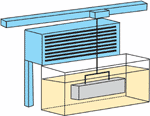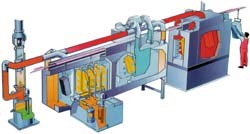Keeping Pretreatment Simple
When Johnston Metalwork decided to add pretreatment to its shop, it didn't want anything complicated, meaning no wastewater treatment or lots of chemicals to deal with...
Up near the top of the Michigan mitten on Lake Huron is Cheboygan, a small town known more for its fishing, hunting, snowmobiling and proximity to Mackinaw Island, than its industry. Here is where Jay Johnston makes his living running Johnston Metalwork Inc., a small welding, fabricating and powder coating job shop.
Mr. Johnston originally operated the shop seasonally as a welding and fabricating shop; he did not offer powder coating. Then he set up a batch system to powder coat some parts. These parts were easy to do since all they required was a quick wipe down and they were ready for coating. "The parts arrived at the shop with some type of clearcoat finish already applied," commented Mr. Johnston.
This worked well for a while, but Mr. Johnston decided, "Why not powder coat more parts? I had already made the investment in the batch system, I decided I may as well make money with it." Therefore, he acquired powder coating customers and made Johnston Metalwork a 12-month a year business. Much of the initial powder coating was for a local company that manufactured steel tube and sheet components for automotive testing equipment.
The local contractor was sending the parts 2 hr away for powder coating, and it was not particularly happy with the results.
However, prior to contracting the business, he had to purchase a pretreatment system, since these parts were not "powder coat ready" as the first job had been.
Mr. Johnston had some requirements in mind before he even started looking for a pretreatment system. It had to be inexpensive, quick and not create any wastewater treatment issues. He found what he was looking for in the Plaforization process from Carpenter Chemicals.
The process is relatively new in the United States, although it is in use in more than 400 plants in Europe and elsewhere in the world. It cleans, phosphates and seals in a single stage, at room temperature, in 1 min of treatment time. The process uses no water, requiring no rinsing or oil disposal. It creates no sludge or water waste, and no daily checking of the bath is required, only a lab analysis every other month.
The bath itself has an unlimited life, requiring only periodic refilling to replace material used in the process. And, Plaforization gives excellent temporary corrosion resistance. This is exactly what Mr. Johnston was looking for.
Savings derive from various sources, including a smaller, single-stage installation; no liquid heating; no wastewater or sludge or oil to treat or dump; and easy operation.
Plaforization plant designing is very flexible, depending on the user's needs. Mr. Johnston designed a simple manual dip operation, although he could have went with a spray system in an automatic or semi-automatic mode. "If I ever decide to automate the facility, which I may do, I would automate this pretreatment process into the powder coating line," stated Mr. Johnston.
Plaforization is a simple process designed to work with the process oils, taking them into solution rather than floating them. Thus, the oils do not need to be removed and dumped.
The fluid also contains the phosphating materials and a polymeric resin. When the part is removed from the treatment solution, a little of the solution is "dragged out" on the part along with some of the process oils. Phosphating occurs during drying and, in addition, the resin polymerizes.
The polymerization captures the process oils inside the polymer, using them as a plasticizer to lend flexibility and impact resistance to the surface sealant. So the part is cleaned and the oil is removed but used in the process. The part is phosphated and sealed in one step.
"The process fit my requirements," noted Mr. Johnston. "I only have to immerse the parts for one minute, and they dry in five to seven minutes at room temperature. Also, I never have to change the solution because the polymer absorbs the oil, and the continuous filtration system removes the dirt. All I really need to do is top off the liquid."
Since no water is used, there is no wastewater disposal or treatment. The process also creates no sludge, so there are also no solid-waste disposal considerations. The solution does not contain any CFCs, HAPs, chrome or ozone-depleting substances. "This is another reason I went with this process. I did not want to have to deal with any wastewater treatment or sludge problems. Because I use this pretreatment and spray powder coating, I have little or no environmental issues," stated Mr. Johnston.
Read Next
Episode 45: An Interview with Chandler Mancuso, MacDermid Envio Solutions
Chandler Mancuso, technical director with MacDermid Envio discusses updating your wastewater treatment system and implementing materials recycling solutions to increase efficiencies, control costs and reduce environmental impact.
Read MoreDelivering Increased Benefits to Greenhouse Films
Baystar's Borstar technology is helping customers deliver better, more reliable production methods to greenhouse agriculture.
Read MoreA ‘Clean’ Agenda Offers Unique Presentations in Chicago
The 2024 Parts Cleaning Conference, co-located with the International Manufacturing Technology Show, includes presentations by several speakers who are new to the conference and topics that have not been covered in past editions of this event.
Read More















.jpg;maxWidth=300;quality=90)








